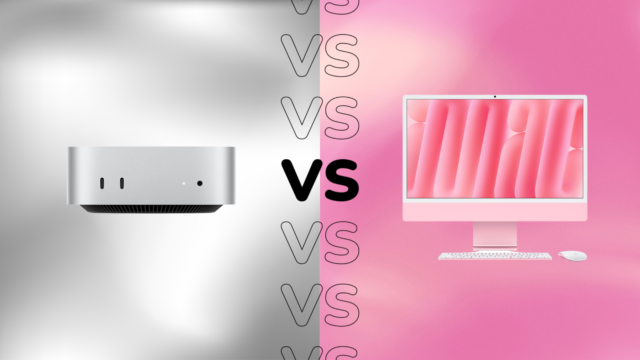Apple has officially brought its M4 chipset to the Mac lineup with the launch of the Mac Mini (M4) and iMac (M4) at the end of October.
The question is, which M4 Mac should you buy? Keep reading to learn all the important differences between these two Apple desktop computers.
Price
The Apple Mac Mini (M4) is available to order today with prices starting at £599 for the M4 with 16GB of unified memory and 256GB of SSD storage. It’s worth noting that you will need to buy a monitor, keyboard and any other peripherals you require separately if you don’t already have these.
The Apple iMac (M4) is also available to order now. Prices start at £1299 for the 8-core M4 with 16GB and 256GB. However, this goes up to £1499 for the same 10-core M4 found in the iMac (M4).
This price includes the iMac, Magic Keyboard (with or without Touch ID) and Magic Mouse.
The iMac (M4) includes a monitor, keyboard and mouse
One major benefit to choosing the iMac (M4) over the Mac Mini (M4) is that the iMac is an all-in-one desktop PC.
There’s no need to worry about picking out a monitor, keyboard and mouse as all three are included in the iMac’s price. They also come in a vibrant range of colours, with the peripherals matching the colour of the monitor for a cohesive and stylish look.
The monitor in question is a 24-inch Retina display with a 4.5K (4480 x 2520) resolution at 218ppi. The screen is capable of reaching 500 nits of brightness and supports P3 wide colour and up to 1 billion colours. The display also features Apple’s True Tone technology and is configurable with nano-texture glass.

Because the iMac includes a monitor, it also comes with a webcam. The 12-megapixel camera produces 1080p HD video and includes support for popular Apple camera technologies like Desk View and Center Stage.
The Mac Mini (M4) is more customisable
While the iMac’s all-in-one design is a pro for many, others might prefer to customise their own PC setup with a monitor, keyboard and mouse of their choice.
If this sounds like you, the Mac Mini (M4) could be the stronger choice – especially if you already own these peripherals as you could save a good chunk of cash on your next upgrade by opting for the Mini.


The Mac Mini (M4) also offers more flexibility in configuring your desktop setup by supporting up to three displays in total. The iMac, comparatively, supports just one additional display.
The Mac Mini (M4) has more ports
Another perk to the Mac Mini (M4) is its wider range of connectivity options.
The Mini includes two USB-C ports with USB 3 support and one 3.5mm headphone jack on its front, as well as three USB-C ports with USB 4, Thunderbolt 4 and DisplayPort support on its rear. There’s also one Gigabit Ethernet port and an HDMI port on the back of the computer for a grand total of eight ports.


The iMac (M4), meanwhile, is available in two configurations. One comes with four ports: two USB-C ports with USB 4, Thunderbolt 4 and DisplayPort support, one 3.5mm headphone jack and one Gigabit Ethernet port. The other features the same array of ports with two additional Thunderbolt 4 inputs for a total of six ports.
Early verdict
The Apple Mac Mini (M4) and iMac (M4) are two Mac computers that take advantage of the same M4 chipset for performance improvements over their previous respective generations.
If you’re looking for an all-in-one solution that includes all the equipment you need to get started, including a monitor, keyboard and mouse, opt for the iMac. Otherwise, you might prefer the ability to customise your setup and additional connectivity options afforded by the Mac Mini.
However, you’ll have to wait for our reviews of each PC to learn how they compare when it comes to performance and real-world use.











